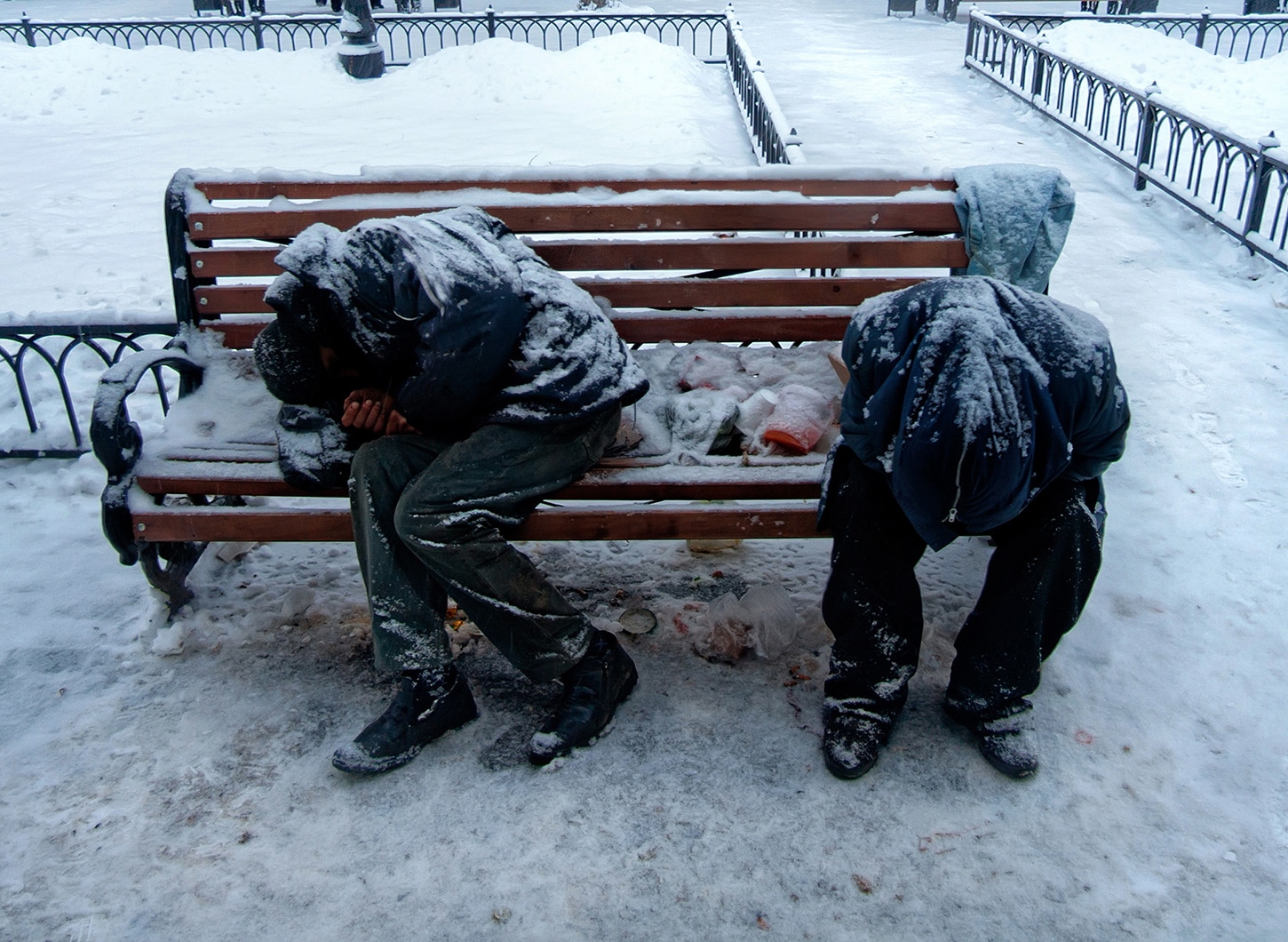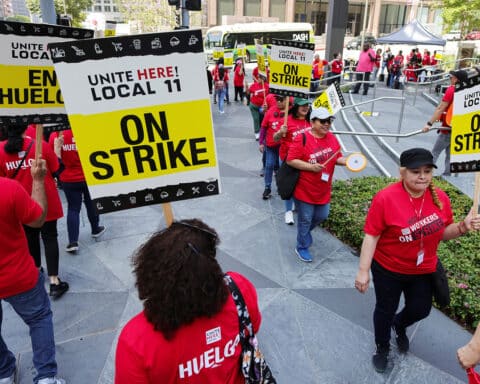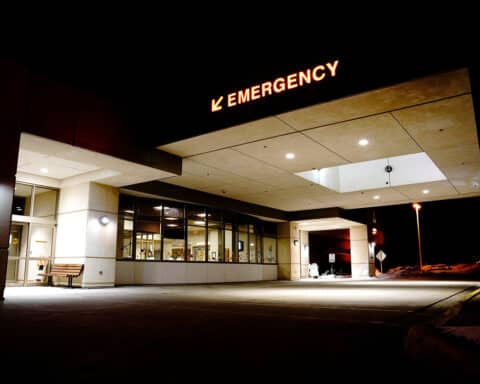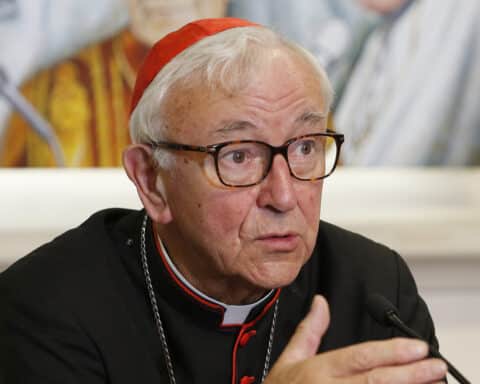ANCHORAGE, Alaska (OSV News) — Solutions are coming but in a race against snowfall for an estimated 1,000 to 3,000 homeless people in Anchorage, heavy snowstorms struck before shelter issues were solved.
Most of that number were still sleeping in tents in late November when the city realized it needed to find more options beyond three new shelter facilities with 500 beds and those operated by Catholic Social Services.
It’s been tragic for many after the closure of the city’s only mass shelter, known as the Sullivan Arena, that accommodated 500 people for the previous four years. After it shut down in June, all but about 90 medically vulnerable people were left with few options outside the Catholic-run Brother Francis Shelter, which has bedspace for 120 people a night.
Lack of shelter as snow falls
Anchorage made national headlines for its plight — hundreds of people pushed out onto streets and city campgrounds. Coupled with that was a record-high death toll: 49 deaths among the homeless, 11 between October 2022 and April 2023 and 38 over the summer and fall. Four died after 30 inches of snow fell in a single November day.
“It’s been tragic and frustrating,” said Anchorage Assemblyman Felix Rivera to KTUU News. Yet, the city was caught off-guard by the larger-than-calculated number of homeless people this winter.
Catholic Social Services partnership
Catholic Social Services prepared ahead knowing it would be a difficult winter, said Robin Dempsey, the agency’s executive director. CSS is a partner with the city and other agencies that care for the homeless population. Brother Francis Shelter, Clare House, which is for mothers and children, and Complex Care, for elders and the handicapped, serve more than 250 people per night.
CSS operates Homeless Family Services, which has case managers working around the clock to help people “transition out of homelessness and experience renewed potential with dignity and respect.”
This year, CSS has new tools to help the people lacking shelter: the 3rd Avenue Resource and Navigation Center. People can go there for support, whether they are living in a car, a tent or a shelter. They can be seen by clinic nurses as well across the street at Brother Francis Shelter.
“Living outdoors is challenging. Not only the cold, but the heat sources of the area where people go to sleep,” Dempsey said, referring to doorways near buildings. “It’s been a huge challenge. A lot of these tents are put together to sleep in and they use various heating sources. There’s risks there,” Dempsey said. Small heaters attached to propane tanks are used in many cases.
“Every single person we talk about has an acute need. We just want to make sure that whatever services we have (are) connected to them,” Dempsey told The North Star Catholic, newspaper of the Archdiocese of Anchorage-Juneau.
At the 3rd Avenue navigation center, people find a helping hand as they check in for a warm shower and charge their phones. It’s also a warm shelter, meaning they can remain there during the day.
Not just short-term tasks can be done there, but long-term “engagement” like case management and employment support, said Molly Cornish, chief communications officer at CSS.
Along with CSS staff, other partner service providers share the facility, so a client at the center can meet with case managers, housing coordinators, or employment specialists all in one location. Since opening in late February, the program has provided resources and services to over 3,000 individuals.
Services at the center
“The most used service at the center are our showers, with over 4,100 showers provided since the opening of the program last February,” Cornish said. “The dignity of 30 minutes alone and uninterrupted in a shower cannot be overstated. Through these services, we hope to provide clients a reinforced sense of self-care and community. This service can also be the first step towards creating a trusting relationship with staff that empowers a guest to seek deeper services from other providers on site.”
Another well-placed service provider is FreeMo, a group distributing free phones through the Affordable Connectivity Program. Food Bank of Alaska offers Supplemental Nutrition Assistance Program benefits and other public assistance outreach.
CSS started a busing service this past summer in response to the homelessness problem. A driver visits tent encampments and other areas “where we know neighbors are sleeping outside,” Cornish said. “We offer a ride to the center and also transportation back to wherever they need to go, after receiving services.”
Municipality’s challenges
The municipality of Anchorage is working toward a permanent solution that’s expensive and complicated and must be hammered out between Mayor David Bronson’s administration and the Anchorage Assembly. In the meantime, the city is working on shelter solutions to get people through the 2023-2024 winter, said Alexis Johnson, the housing and homeless coordinator with the Anchorage Health Department.
With no mass shelter — a place anyone could walk up to and get a bed for the night — the city’s hundreds of homeless people were forced to camp mainly in three encampments around Anchorage. These were public parks, plus one historically used as a homeless camp at Davis Park.
By law, the city couldn’t evict or “abate” the campers because it’s not a crime to be homeless.
A 2018 ruling by the U.S. Court of Appeals for the 9th Circuit held that cities cannot enforce anti-camping laws if they don’t have enough homeless shelter beds available for their homeless population.
The decision was handed down in Martin v. Boise in response to a 2009 lawsuit by six homeless plaintiffs against the city of Boise, Idaho, regarding the city’s anti-camping ordinance. The decision was based on the U.S. Constitution’s Eighth Amendment against cruel and unusual punishment.
Anchorage consequently won’t clear out the camps until there are enough shelter beds for those signed up. A waitlist shows 500 more than the city calculated as needing housing.
Parishes assist
CSS finds that it receives generous donations from parishes and donors as it helps in numerous ways to serve the needs of homeless neighbors. Warm clothing, heat warmers, socks, hats and mittens are especially needed. “Parishes have been very generous — so I want to give a big shout-out to them,” Cornish said.
“Our job is to make sure shelter opportunities are available,” Dempsey said. “And I want to stress that it will be hard to transition from the camps to shelter beds. I want to remind people that we need to be compassionate and stay vigilant with those that need the help.”
Naomi Klouda writes for The North Star Catholic, newspaper of the Archdiocese of Anchorage-Juneau.





